129,000 Years Ago
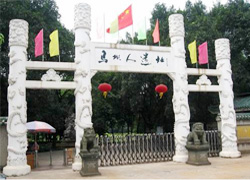
Maba Men relics in Qujiang District, Shaoguan
Qujiang Maba Men were found living here as early as 129,000 years ago, who turned over the first page of the Guangdong social history as the earliest human beings ever found here. As the legend goes, the ethnic Yue people resided here in ancient times. That is why Guangdong is also called Yue for short in Chinese.
214 BC
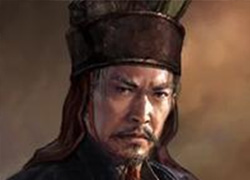
Portrait of Ren Xiao
In 214 BC, the 33rd Year in the Reign of Qin Shihuang in the Qin Dynasty, Qin Shihuang, the first emperor of China, sent his loyal army led by General Tu Sui to conquer Lingnan Region. Three shires were set up: Nanhai, Guilin and Xiang. Later, Ren Xiao, the first prefectural commissioner of Naihai Shire, constructed a walled city at Panyu, which was also called Renxiao Town or Qincheng Town. Panyu Town in history is regarded as the starting point where Guangzhou developed into a big city.
206 BC
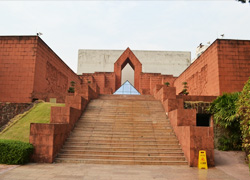
Museum of the Western Han Dynasty Mausoleum of the Nanyue King
206 BC was the First Year of the First Emperor of the Han Dynasty. When Zhao Tuo became the successor of the prefectural commissioner of Nanhai, he made himself king of Nanyue Kingdom entitled King Wuwang with Panyu the capital for the first time in history. He expanded the city of Panyu and renamed it Zhaotuo Town. It was also called Nanyue Town in history.
887 BC-206 BC
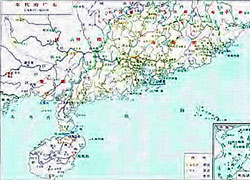
The map of Guangdong in the Qin Dynasty
Far early back, it was called Nanyuedi in the Period of Spring-Autumn (770-476 BC) and long back in the Period of Warring States (475-221 BC). In the 8th year of Emperor Yi of the Zhou Dynasty (887 BC), the capital of the Chu State was in the present location of Guangzhou. After Emperor Qin Shihuang, the first emperor of China, unified the whole land of China, Nanhaijun was founded (214-206 BC) in the present Guangdong territory with Panyu (now Guangzhou) as its capital. During the Han Dynasty, Guangdong belonged to Jiaozhou.
226 AD
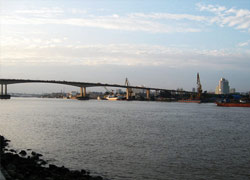
Today's Panyu
In 226 AD, the 5th Year in the Huangwu Reign in the Wu State, Guangzhou was separated from Jiaozhou and Guangzhou got its name then. Guangzhou was in the north, under its administration there were four shires: Nanhai, Cangwu, Yulin and Hepu. Panyu was made the capital of Guangzhou.
917 AD
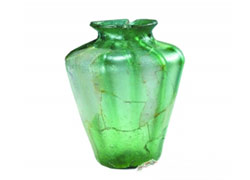
Islamic glassware of the Southern Han Dynasty
917 AD (the 3rd Year of the Zhengming Reign in the Late Liang State) General Liu Yan, taking the advantage of the wars between the local lords in Central China, declared independence. Dayue Kingdom was set up with Guangzhou the capital, and then changed to the Southern Han Dynasty the next year.
226 AD-1644 AD
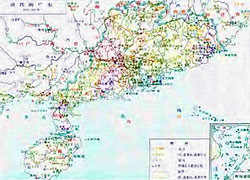
The map of Guangdong in the Qing Dynasty
In the period of the Three Kingdoms, it was part of the Wu State ruled over by Sun Quan. In the year 226 AD in the Tang Dynasty, Guangdong and Guangxi were combined into one administrative region called Lingnandao. In the first year of the Zhenghe Reign in the Song Dynasty, it was changed into Guangnandonglu (960-1127 AD). In the Yuan Dynasty, Guangdongdao came into being; Guangdong Buzhengsi (Guangdong Pacification Commissioner's Office) in the Ming Dynasty (1368-1644), and finally in the Qing Dynasty was Guangdong Province set up with fixed administrative territory up to the present.
6th-15th Century

Burial object of the Northern and Southern Dynasties
Guangdong Province has a 2200-year-long history with a long-established administrative status in China. But social advancement had been much slower than Eastern and Northern China until the Song Dynasty, and then in the Ming Dynasty, Guangdong kept up with the Yangtze and the Yellow River valleys. Guangdong began stepping into the rank of advanced provinces afterwards. Although Guangdong embarked on the road of development a bit late, its commodity production started rather early. According to the historical records found, in the 6th century during the Southern and Northern Dynasties, sugarcane in Guangdong had been distinguished into two categories for the market: fruit sugarcane and grain sugarcane. Sugar can be extracted from the latter and be sold at the market.
1646 AD
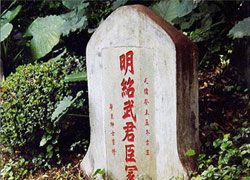
The tomb of Zhu Yuyue and his 14 subjects
1646 AD (the 3rd Year in the Reign of Emperor Sunzi in the Qing Dynasty) The Southern Ming Dynasty was restored in Guangzhou with Zhu Yuyue the Emperor. This was the third time that Guangzhou was selected in history the capital. But this short-lived dynasty survived only for 40 days, soon destroyed by the Qing royal army.
1839 AD
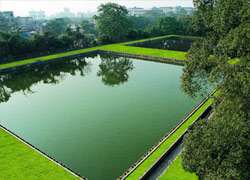
The pit for destroying opium in Opium War Museum
1839 AD (the 19th Year in the Reign of Emperor Daoguang in the Qing Dynasty) Lin Zexu (1785-1850), the envoy of the Qing Government to Guangzhou, carried out the embargo on the British opium trade. He ordered to confiscate 20,000 boxes of British opium and burned them all up on the beach of Humen Port. So the first opium war broke out then.
1841 AD

The monument of the movement in Sanyuanli, Guangzhou
1841 AD (the 21st Year in the Reign of Emperor Daoguang in the Qing Dynasty) Sanyuanli Struggle against the British invaders took place and this is the first time that the Chinese people organized themselves on a large scale to fight against foreign invasions.
1856 AD

Guhai Battlefield of the Opium War in Humen Port, Dongguan
In 1856 AD (the 6th Year in the Reign of Emperor Xianfeng in the Qing Dynasty), British Navy launched a second opium war upon the Qing Government on the excuse of the incident of the British ship Arrow. Guangzhou fell into the control of the British invaders for a while. Guangzhou urbanites soon stood up and defeated the invaders.
1840s AD - 1941 AD
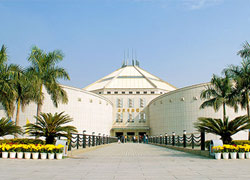
The Sea Battle Museum in Humen, Dongguan
Guangdong has also taken up an important position in China's modern history. Many important historic events took place in Guangdong, such as the Opium Wars (1840s), Taiping Rebellion, the 100-Day Reform Movement (1898), the Xinhai (1911) Revolution, the Northern Expedition, Neo-Nationalist Movement, Sanyuanli Struggle against the British Invaders (1941), the Guangzhou Uprising, and the Great Strike in Guangzhou and Hong Kong. History has witnessed in this remarkable place generations of prominent figures and momentous events. In the past century, Guangdong has been well-known for its revolutionary tradition, its national celebrities and heroes like Lin Zexu (1785-1850), Hong Xiuquan (1814-1864), Deng Shichang, Guan Tianpei (1781-1840), Huang Zunxian (1848-1905), Kang Youwei (1858-1927), Liang Qichao (1873-1929), Zhan Tianyou (1861-1919), Qiu Fengjia (an educator, 1864-1912), Sun Yat-sen (1866-1925), Feng Ru (the first aircraft designer in China, 1883-1912), Xian Xinghai (a nationally famous musician, 1905-1945) and Ye Jianying. They have left behind much memorable heroic legacy.
1886 AD - 1872 AD

A model of steam-powered reeling machine designed by Chen Qiyuan, the founder of Jichanglong
Under the influence of the Western culture and with the help of the Western capital and technology after the Opium Wars, a Western-style munitions factory was built in Guangzhou in the 5th year of the Tongzhi period of the Qing Dynasty (1886). This was the predecessor of the Hanyang Munitions Factory in Wuhan City in Central China. In 1872, the Nanhai Jichanglong (Steel) Rolling Mill was built, which was one of the first modern factories of Chinese national industry at that time. Thus Guangdong became one of the national modern industrial bases in China.
1917 AD
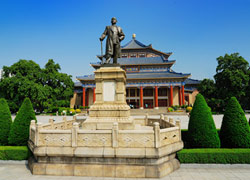
Bronze statue of Dr. Sun Yat-sen in Guangzhou
The Law Enforcement Military Government of the Republic of China was founded with Dr Sun Yat-sen as Generalissimo of the Army.
1921 AD
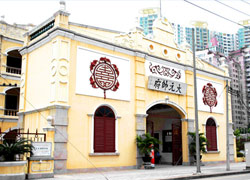
Memorial Museum of Generalissimo Sun Yat-sen's Mansion in Guangzhou
The Government of the Republic of China was establishment in Guangzhou in 1921 AD. Dr Sun Yat-sen was appointed the first president of the country. The Republic of China is the first republic in Asia ever set up in history.
1926 AD
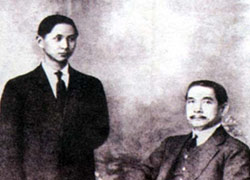
Sun Ke and his father in Honolulu in 1910
Improved by Generalissimo Sun Yat-sen, the planned administrative territory of Guangzhou was ratified in 1925 AD, covering an area of 537 sq km from Chebei (in Dongpu) in the east to the two islands of the Pearl River in the west and from Mt. Baiyunshan in the north to Huangpu in the south. Sun Ke became the first mayor of Guangzhou in 1926.
1949 AD

A pailou set up on Yonghan Rd. to celebrate Guangzhou’s liberation
In 1949 AD, the People's Republic of China was founded. Guangzhou was liberated from the control of KMT (the Nationalists).
1972 AD - 1974 AD

Chow mein, means "fried noodles"
As the southern gateway to China, Guangdong has always been open-minded to both Central China and the outside world. It has not only inherited the traditional Chinese culture, but also kept intermingling with the Western civilization. Those exchanges can be traced far back into history. From merely the Cantonese borrowings in English, one can figure out the close contact between Guangdong and the West. For example, there are over 20 in Oxford Advanced Learner's Dictionary of Current English (London 1974)): chopsuey, chow mien, litchi, kaolin, wampee, sampan, taipan, toss, soy, tea and pailou. In Webster's New World Dictionary of the American English (New York 1972), there are more than 30, such as yen, catchup (ketchup), chopsticks, typhoon, tong and chopsuey.
1978 AD

Bronze statue of Deng Xiaoping in Shenzhen
Major activities of the first cooperation between the Chinese Communist Party and the Chinese Nationalists (KMT) were also carried out here and have also left behind many memorable historical sites and stories of time. Today is no longer yesterday with yesterday's suffering and humiliation gone forever. What is most attractive is Guangdong today. Since China adopted the policy of reform and opening up in 1978, Guangdong has transformed itself amazingly, creating a prosperous society in only two decades and leading the way right to the four modernizations and to globalization in China. The following are the great historical events in Guangdong administrative history.
1980 AD

Guangzhou in the initial stages for reform and opening-up
Guangzhou was elected one of the five pilot cities opened first to the outside world in 1980 AD. Since then, great changes have taken place. Guangzhou's per capita disposal income reached 13,967 yuan in the year 2000, sixty times as much as that of 1978.
2000 AD
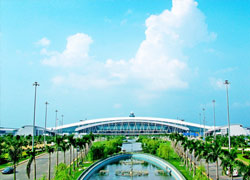
Guangzhou New Baiyun International Airport, completed in 2004, is an important achievement of construction in modern Guangzhou.
The 10th Five-Year Plan (2001-2005) of Guangdong was ratified, and according to it, Guangdong plans to realize its four modernizations ahead of schedule in 2005. Its GDP will reach the same amount as that of Hong Kong at that time, with over US $7,000 per capita GDP.
2006 AD-2010 AD

Closing Ceremony of the 16th Asian Games held in Guangzhou on Nov. 27, 2010
The overall economic strength of Guangdong reached a new high. In 2010, the province's GDP reached 682 billion US dollars and its average annual growth rate was 12.4%. The industrial structure was further optimized, with the ratio between the primary, secondary and tertiary industries being 5.0: 50.4: 44.6. People's livelihoods were visibly improved, with the per capita urban disposable income and the per capita rural net income respectively rising 7.6% and 8.3% annually in the five years. In 2010, imports and exports totaled 784.7 billion US dollars, and the average annual rate was 12.9%.
2011 AD-2015 AD
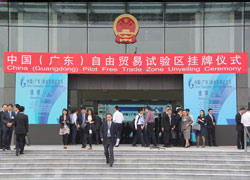
China (Guangdong) Pilot Free Trade Zone unveiling ceremony
During the 12th Five-Year Plan period, Guangdong's GDP hit 7.28 trillion RMB in 2015, compared to 4.6 trillion RMB in 2010 with an 8.5% annual growth rate from 2011 to 2015. Guangdong's economy growth emphasized "quality over speed" in these five years, and the economic comprehensive strength stepped into a new level. The per capita GDP increased from 44,800 RMB to 675,000 RMB, an average annual increase of 7.5%. Innovation capacity ranks second in China, research and experimental development expenditure accounted for the ratio of GDP from 1.76% to 2.50%, high-tech products accounted for the proportion of total industrial output value increased from 34.2% to 39.0%.
























